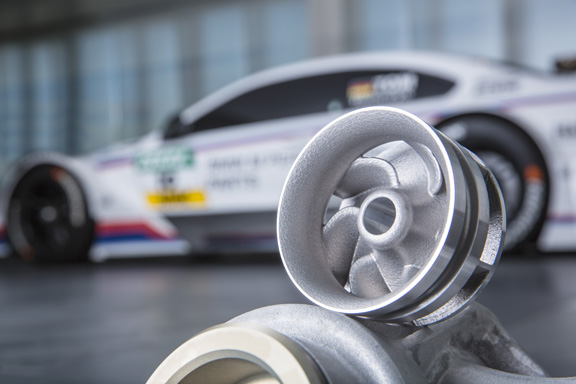
BMW’s 3D-printed water pump, built from an aluminum alloy powder. Image courtesy of BMW.
Latest News
November 12, 2015
 BMW’s 3D-printed water pump, built from an aluminum alloy powder. Image courtesy of BMW.
BMW’s 3D-printed water pump, built from an aluminum alloy powder. Image courtesy of BMW.A few weeks ago, I joined a panel of composite experts for the webcast titled “It’s a Material World: Opportunities and Risk in Working with Advanced Materials.” The lively discussions were driven by:
- Craig Blue, CEO, Institute for Advanced Composites Manufacturing Innovation (IACMI)
- Dr. Vlastimil Kunc, Materials Engineering, Oak Ridge National Laboratory
- Russell Elkin, Baltek Inc.
During his opening remarks, IACMI’s Blue said, “Composites have been around for decades, especially in the high performance market. Large scale, pervasive use of it in vehicle market really hasn’t happened yet, but the new CAFE standards [U.S. regulation to address fuel economy] play a critical role in lightweighting. So now we have a technology pull, as opposed to a technology push.”
Baltek’s Elkin said, “From strength and density, composites are far superior to metal. But the issue generally is stiffness. People look at strength, but really, when designing, you’re dealing with stiffness problems.” Elkin explores sandwich solutions—stacking up different materials to create the desired properties—for his clients.
Oak Ridge National Lab’s polymer research lead Kunc said, “What really excites me is the convergence of composites and additive manufacturing. We are addressing two key barriers to widespread application: One is the cost of raw material, specifically carbon fiber; the other barrier is the cost of tooling, both money and time.”
During discussion, Kunc pointed out the two types of data required to effectively simulate composite design’s behaviors: “input data for the model, which sometimes we have a difficult time obtaining; and validation data, from test cases that ensure that your model gives you reliable results. The difficulty with composites is, they’re non-standard and process-dependent, so I cannot go look them up in a handbook.”
The webcast prompted some questions from the viewers. Here are some, along with responses from me and panelist Russ Elkin:
Question: I am interested in the design of composites for organic/stylistic shapes. We had a welding helmet made of fiber glass, but it was very boxy. How has the technology changed in the past 10-15 years to allow more organic/modern design styling?
Response by panelist Elkin: I would guess the reason for a “boxy” welding helmet was simply the design of that specific part and not a limitation of composites in general. If you look at the wide variety of parts engineered and constructed with composites, the designs are very organic. Hockey goalie, baseball catcher, and bicycle helmets are excellent examples.
Attendee comment: The Composites Materials Handbook was mentioned as having been written in the ‘70s. The handbook was updated in 2012 with newer information (http://www.cmh17.org/).
Response by panelist Elkin: I was not referring to this database, which is the evolution of Mil handbook 17. This reference is not a “how to.” Handbook of Composites, edited by George Lubin, was originally published in 1982 with a second edition in 1998. Tier I & II automotive part manufacturers are typically small businesses. Often, when I have been asked to consult on using composites at these OEMs, they pull out this book. The lack of better information about composite design and molding processes is a hindrance to further use of composites, specifically in the transportation market.
Question: Are Adhesives used in tension joints?
Response by panelist Elkin: This is not recommended.
Response by moderator Wong: I recently interviewed executives at Dow Automotive, which specializes in the use of adhesives for bonding composites. They’re featured in the article “Advanced Materials Allow Engineers to Print, Glue and Drive!” You can reach them at http://www.dowautomotive.com.
Question: How much material testing is commonly done in our industries?
Response by panelist Elkin: Quite a lot. For example, my company performs semi-annual testing on our products as part of our internal quality control. Furthermore, many customers require a “type approval” or independent verification of the mechanical properties. These are often renewed every 5 years.
Response by moderator Wong: Some simulation software developers test and validate composite materials so they can incorporate the data into their software packages. HBM nCode, for example, operates the Advanced Materials Characterization and Test (AMCT) Facility in Darley Dale, Derbyshire. Test results are part of the database in nCode’s software like GlyphWorks and DesignLife.
Question: How much mass is typically saved using composites?
Response by panelist Elkin: The answer is one of the most common given when discussing composites—“It depends.” For example, I believe Boeing estimated a weight savings of
Subscribe to our FREE magazine, FREE email newsletters or both!
Latest News
About the Author
Kenneth Wong is Digital Engineering’s resident blogger and senior editor. Email him at [email protected] or share your thoughts on this article at digitaleng.news/facebook.
Follow DERelated Topics






